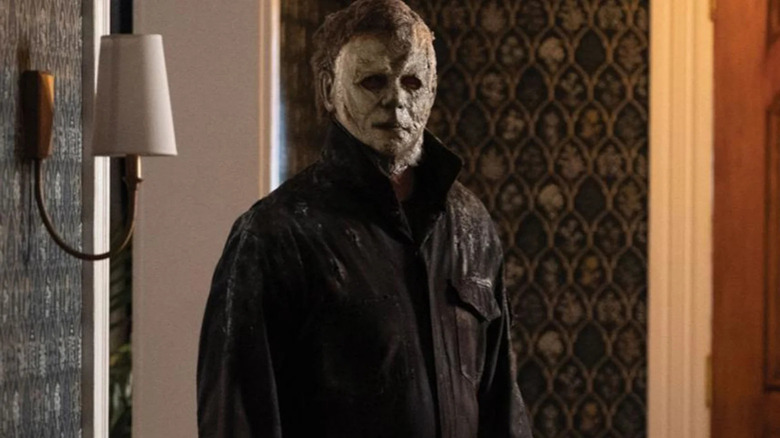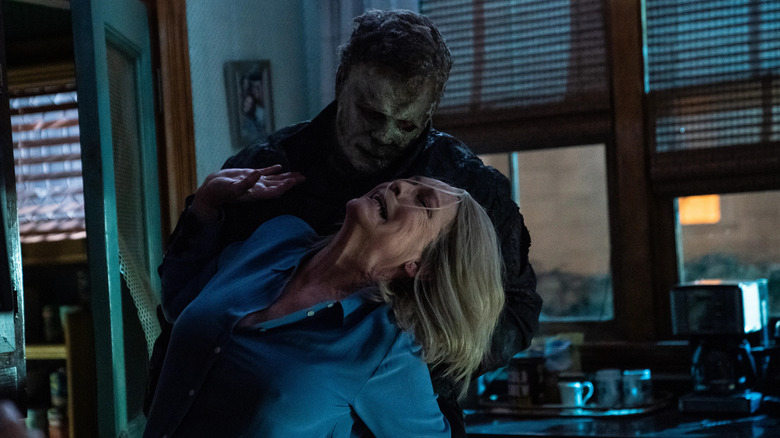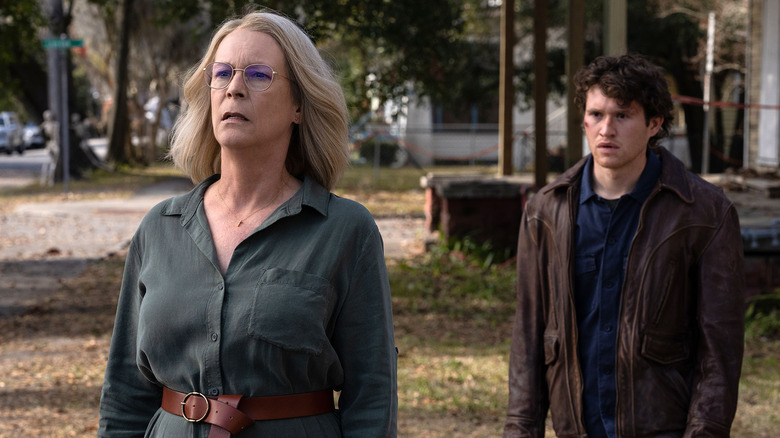David Gordon Green Knew The Backstory Of Michael Myers Was Forbidden Territory For Halloween Ends
We all know Michael Myers' origin story from 1978's Halloween. He kills his sister at six, breaks out of an asylum at 21, and begins a 12-movie killing spree ("Halloween III" excluded). Throughout this time, he goes in and out of psychiatric detention, dies multiple times, and then is either resurrected or rebooted.
Beyond that, there's not much else we need to know about him. He is a near-featureless killer, hell-bent on brutally murdering as many people as he can get his hands on, though he usually starts with immediate family members. This is exactly how the newest trilogy in the "Halloween franchise uses him, and according to director David Gordon Green, this was very intentional.
Forbidden territory
Green's trilogy of Halloween films deliberately gives little insight into who Michael Myers is behind the mask. From the moment Myers is reintroduced as a chained up prisoner in broad daylight in 2018's "Halloween" to the conclusion of the third film, we never see an unobscured shot of his face, and we are left to guess exactly what he looks like. Clearly this was one way that Green sought to distinguish himself from other "Halloween" movies, as there is precedent for Michael Myers revealing his face in the original 1978 film and "Halloween 5".
In the same sense, Green did not want to delve any deeper into explanations of why exactly Michael Myers is evil or the supernatural sources of his power, as other "Halloween" entries have. In and interview with A.V. Club, he explained:
"You're not going to go into a Michael Myers backstory because as far as I'm concerned, that's forbidden territory. I don't want to know his motivation, what inspires him."
Green's disinterest in Myers' backstory explains his decision to ignore plot developments from the other sequels, such as Laurie Strode's (Jamie Lee Curtis) sibling connection to Myers — first revealed in 1981's "Halloween II" and repeated in 2009's "Halloween II," during Rob Zombie's directorial run. Consistent with scrapping the Myers lore, Green's films avoid any over-exposition of Myers' personal history like flashbacks to his childhood, also done in Zombie's "Halloween II."
Cruelty breeds more cruelty
While they allocate more than enough screen time to the inventive Michael Myers kills that we all came to see, David Gordon Green's "Halloween" movies are interested in more. With the entire town rallying to hunt down Myers and chanting "Evil dies tonight!" (in homage to "Halloween 4"), "Halloween Kills" showed the effect that Myers has had on Haddonfield. Now, "Halloween Ends" asks if instead the town itself is the cause of evil. Green explained:
"I do ask a lot of questions about evil and community that have been left in the aftermath of the Haddonfield massacres."
Green's films succeed in placing Laurie and her family at the forefront of the story and above the legendary killer in importance. "Halloween Ends" again cares more about its central characters, including introducing an entirely new one. Through Corey (Rohan Campbell), Green is able to link the themes of whether Haddonfield created Myers or vice versa:
"Trying to find a way to ask these questions, but not [doing that] through Michael Myers insisted I bring in a new character to give a perspective of Michael and his behaviors, Laurie and her insights, and then Haddonfield as a whole."
Perhaps in reference to "Halloween 4," in which Jamie Lloyd (Danielle Harris) attacks her foster mother after touching Myers' hand, the newest film uses the idea of physical contact with Myers (when he chokes Corey in the sewers) to show how his evil can be contagious — especially for those who have been tormented by Haddonfield. This idea may not have been set up perfectly in Green's first two films, but considering he only had a "plan of essence" before shooting his trilogy, we can appreciate that Green found something to say at all.


